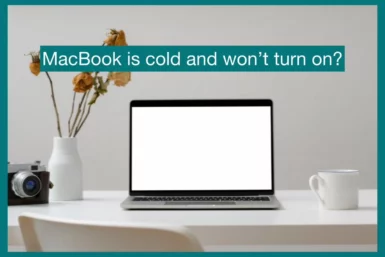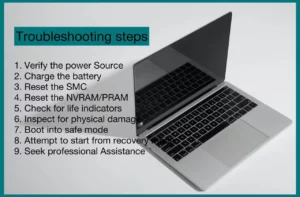Is your MacBook cold and won’t turn on? Dont panic because electronic device technical problems are rather common, and we’re here to assist.
This article will examine the causes of your MacBook’s coldness and offer solutions to quickly get it working again. Let’s start now!
Can Your MacBook Be Damaged by Cold?
Yes, low temperatures have the potential to harm your MacBook. The battery may function poorly in cold temperatures, draining power more quickly or possibly failing to maintain a charge.
When moving from cold to warm conditions, condensation may build within the laptop, causing short circuits and interior corrosion.
The display and other components may become more fragile due to the cold, increasing the possibility of cracks or breaks.
What to Do if Your MacBook is Cold and Won’t Turn On?
It can be frustrating if your MacBook is cold and won’t power on. Before contacting a professional, you can try some troubleshooting methods explained to try to fix the problem.
Let’s go over each step in more detail:
1. Verify the Power Source
Ensure your MacBook is plugged in and the charger is functioning properly. Try using a different power outlet or charger to rule out any possible power supply concerns.
2. Charge the Battery
Your MacBook cannot turn on until it receives some charge if the battery is entirely discharged. Before trying to switch it on again, plug in the charger and let it charge for at least 30 minutes.
3. Reset the SMC
Your MacBook’s System Management Controller (SMC) controls all power-related operations. Power-related issues can occasionally be resolved by resetting them.
To accomplish this, turn off your MacBook and simultaneously press and hold the power button and the Shift, Control, and Options buttons present on the left side of the built-in keyboard. Turn on your MacBook by depressing the power button and all other keys.
4. Reset the NVRAM/PRAM
Various settings for your MacBook are stored in the Non-Volatile Random-Access Memory (NVRAM) or Parameter RAM (PRAM). Your MacBook may need to be reset if it is not responding.
Switch off your MacBook, then switch it back on while holding the ‘Option,’ ‘Command,’ ‘R,’ and ‘P’ keys simultaneously to reset the NVRAM/PRAM. Hold the keys for roughly 20 seconds, then let them go.
5. Check for Life Indicators
Listen for any sounds when pushing the power button or any activity indicators, such as the sleep indicator light turning on. These may offer hints as to the fundamental problem.
6. Inspect for Physical Damage
Look for any dents, cracks, or liquid spills on your MacBook. Maybe physical damage is keeping it from turning on.
7. Boot into Safe Mode
Try starting your MacBook in Safe Mode if it’s having trouble starting. Only necessary system software is installed in this mode, which can assist in locating and resolving problems caused by third-party applications or drivers.
Turn on your MacBook, then hold the Shift key until the Apple logo appears to enter Safe Mode.
8. Attempt to Start from Recovery Mode
Try restarting your Macbook in recovery mode by holding down the Command and R keys. After that, you can try different recovery methods, like reinstalling macOS or recovering data from a Time Machine backup.
9. Seek Professional Assistance
If none of the above measures worked, there may be a hardware problem. For further analysis and repair in this situation, bringing your MacBook to an approved service facility or an Apple Store is preferable.
Prevention Techniques
You may take several precautionary steps to keep your MacBook in good shape and lower the likelihood of problems if you want to avoid running into troubles with it. Here are a few useful pointers:
1. Keep It Up to Date
Update the firmware, operating system, and programs on your MacBook regularly. Bug fixes and performance enhancements are frequently included in software upgrades, which can improve the stability and security of your device.
2. Use Genuine Accessories
Always use genuine Apple cables, chargers, and other accessories made expressly for your model of MacBook. Third-party accessories may fall short of quality requirements and damage your device.
3. Protect from Extreme Temperatures
Keep your MacBook away from extremely hot or cold conditions. While cold temperatures can harm the battery and other internal components, high temperatures can potentially overheat.
4. Use a Protective Case
Consider buying a high-quality protective case to protect your MacBook from nicks, dings, and mild impacts while in use or while traveling.
5. Keep It Clean
Regularly clean the ports, keys, and screen of your MacBook. Over time, dust and dirt can build up and hinder functionality.
6. Practice Safe Charging
Use safe charging techniques by not overcharging your MacBook or leaving it plugged in for too long. Unplug the charger when fully charged to prevent further stress on the battery.
7. Backup Your Data
Your vital files and data should be regularly backed up to an external hard drive, online storage, or Time Machine. In the event of sudden issues or hardware failures, this precaution helps to safeguard your data.
8. Enable Firewall and Security Features
Use your MacBook’s built-in security and firewall capabilities to shield it from potential dangers and illegal access by turning them on.
9. Install Antivirus Software
Although macOS is generally secure, you might want to add a second line of defense against viruses and malware by installing reliable antivirus software.
10. Manage Storage
To free up storage space, periodically evaluate and remove unused files and programs. Better performance is a result of a storage system that is well-maintained.
Conclusion
Finally, properly maintaining your MacBook is crucial to ensuring its best performance and lifespan. Preventative precautions include utilizing genuine accessories, avoiding very hot or very cold weather, and performing routine maintenance.
Try simple troubleshooting if problems develop, but don’t be afraid to get help from a professional if necessary. Maintain the dependability of your MacBook and benefit from its seamless operation.



